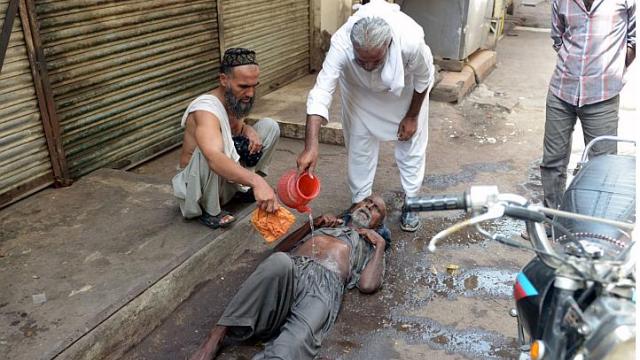
The death toll from the severe heat wave in southern Pakistan over the past week has climbed to 1,233, despite cooler temperatures bringing some relief to residents, health officials said. Even as temperatures appear to have hit their peak, leading meteorologists are warning that longer, more intense heat waves can be expected in the future.
In Karachi, Pakistan’s economic center of around 20 million people, the temperature came down to 34 degrees Celsius (93 degrees Fahrenheit) on Saturday, after reaching 45 degrees Celsius (113 degrees Fahrenheit) at the peak of the heat wave last week.
Nazar Mohammad Bozdar, operations director at the Provincial Disaster Management Authority, said on Saturday that 65,000 heatstroke patients had been treated at the city’s hospitals since June 20. About 2,000 patients with heat-related ailments are still being treated, Bozdar told the AP news agency.
The victims of the heat wave have died of heat stroke, dehydration or other heat-related illnesses, with the elderly and poor the worst-affected groups. With a death toll surpassing 1,200, this is by far the deadliest heat wave in the country’s history. According to statistics from EM-DAT, the International Disaster Database, Pakistan’s previous deadliest heat wave was in 1991, when 523 people died.
The heat wave struck Karachi at a time when the city’s Muslim majority was observing the dawn-to-dusk fasting month of Ramadan, further worsening the situation. Repeated power outrages across the province, and particularly in Karachi, also exacerbated the situation, leaving many residents with no respite from the deadly heat.

With power outages plaguing much of the country, residents have been left with no escape from the deadly heat that has already killed over 1,200 people.
Three weeks ago, India faced a similar deadly heat wave, which saw 1,200 people killed as temperatures hit nearly 50 degrees Celsius (122 degrees Fahrenheit). Both events rank among the ten deadliest heat waves in world history.
Qamaruz Zaman Chaudhry, a vice-president of the World Meteorological Organization (WMO) and former director of Pakistan’s Meteorology Office, says the link between these events is climatic warming. “If we look at the frequency and the trend of the extreme weather events impacting Pakistan then it is easy to find its link with climate change,” he told The Guardian.
Chaudhry wrote Pakistan’s climate change policy and authored a report on the number of heatwaves in Pakistan in 2013. According to his report, the number of heatwaves across the country has increased from 1980 to 2009, and the average temperature throughout the Indus Delta is “steadily rising.”
In May 2010, temperatures in Mohenjodaro in the Sindh province reached 53.5 degrees Celsius (128 degrees Fahrenheit), the fourth highest temperature ever recorded in the world and the highest ever in Asia, The Guardian reports.
Asif Shuja, former director of the Pakistan Environmental Protection Agency, echoed Chaudhry’s assessment, saying that the soaring temperatures are an impact of climate change, fueled by rapid urbanization, deforestation, and automobile use. “The last 30 years – from 1993-2012 – had been warmer than the last 1,400 years. Scientists envisage a rise of 1-6.67°C [1.8-12 degrees Fahrenheit] in temperature till 2100, which will be disastrous,” he told the Express Tribune.
As climate change worsens, experts say the region can expect longer, more intense and more frequent heat waves, as well as other extreme weather events such as heavy rainfall and subsequent flooding. The resulting human toll is likely to be devastating, health officials warn.

The death toll over the past week makes this heat wave the deadliest in Pakistan’s history — and experts say even more severe heat events are coming.
“With the coming of the monsoon rains this year, we have already begun to see an increase in cases of diarrhea. This is because of contaminated drinking water,” Isaac Chikwanha, medical coordinator for Médecins Sans Frontières (Doctors Without Borders) in Pakistan, told The Guardian. “Heat strokes and dehydration are common among children and adults before the monsoon season when the temperature rises.”
“The rise in vector-borne diseases including diarrhea, cholera, gastroenteritis, typhoid and hepatitis is due to environmental factors and the effects of climate change,” said Iqbal Memon, president of the Pakistan Pediatric Association. “The Indus River used to flow at full strength prior to the monsoon season and freshwater was abundantly available. Now there is no water in the Indus River. Ponds and rivers in Sindh have become contaminated, but people have no other option but to use that water for drinking and cooking. This lack of freshwater is purely due to environmental reasons.”
The World Health Organization describes climate change as one of the most rapidly emerging and widespread public health threats that the world has ever faced. Over the last 50 years, human activities – particularly the burning of fossil fuels – have released sufficient quantities of carbon dioxide and other greenhouse gases to trap additional heat in the lower atmosphere and affect the global climate. In the last 100 years, the world has warmed by approximately 0.75oC. Each of the last 3 decades has been successively warmer than any preceding decade since 1850. As a result, sea levels are rising, glaciers are melting, and precipitation patterns are changing; extreme weather events are also becoming more intense and frequent.
Already, seven million people die prematurely each year because of air pollution — that’s one in eight total global deaths. And tens of thousands more die from shifting patterns of disease and extreme weather events, such as heat waves and floods. The WHO expects that climate change will cause approximately 250,000 additional deaths every year between 2030 and 2050 due to heat exposure, diarrhea, malaria, and childhood under-nutrition.
